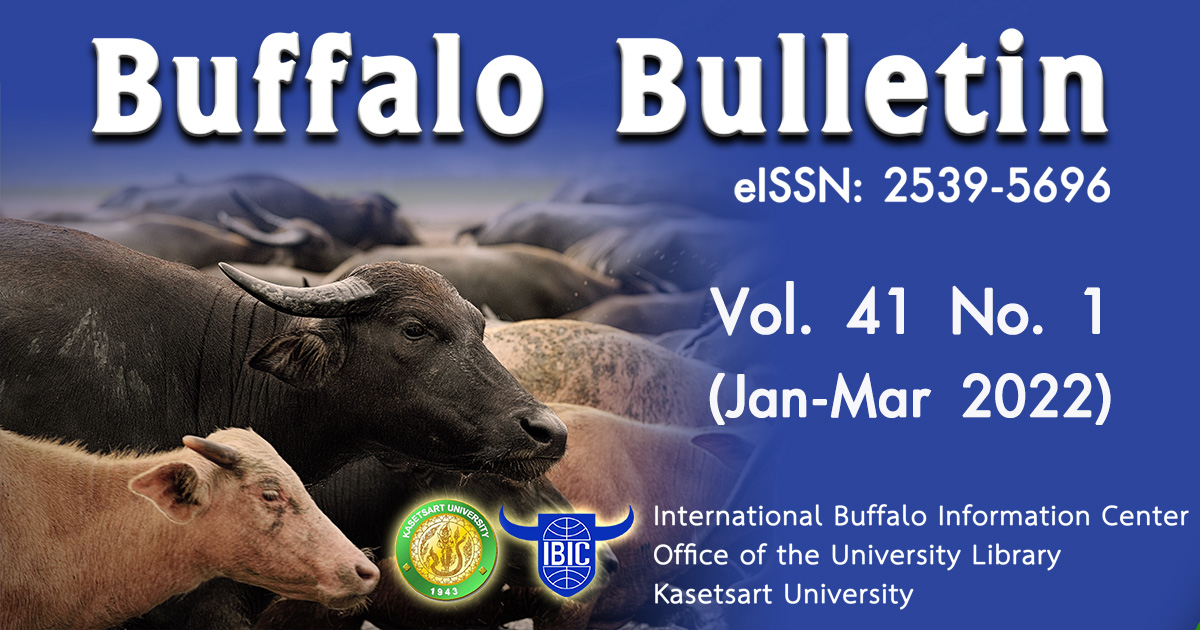Adoption scores for buffalo-based technologies in the Philippines as influenced by socio-economic, technological, communication, and institutional factors
DOI:
https://doi.org/10.56825/bufbu.2022.4114043Keywords:
Bubalus bubalis, buffaloes, technology adoption, dairy buffalo, sigma score, impact zoneAbstract
The study aimed to analyze the adoption of 22 technologies on dairy buffalo production in selected sites in the Philippines. A total of 666 farmer-informants who were previously exposed to training and other extension support services on dairy buffalo production were interviewed using semi-structured questionnaire. Dichotomous (yes or no) frequency and percentage responses along five stages, i.e., “awareness”, “interest”, “evaluation”, “trial”, and “adoption” were transformed to sigma (Z) scores for adoption. Frequency responses for “number of years of adoption” were likewise transformed to sigma scores. The two sigma scores were added to get the total adoption scores for each technology. The total or combined adoption scores (dependent variable) for all technologies were then tested for linear correlation and multiple regression with selected socio-economic traits, farm characteristics, and other independent variables. Most of the farmer-informants had at least 75% adoption rate in animal health care, improved forage feeding, estrus detection, and feeding of calves with colostrum. Multiple regression analysis indicates that attribution scores, years of experience in dairying, technical assistance, animal inventory, distance of the farm from a buffalo R and D institution, access to information materials and income from dairying positively and significantly influenced adoption scores. To increase adoption, improving the attribution by farmers to technologies as regards their relative advantage, compatibility with existing farm operations, trialability, and simplicity should be given priority consideration in designing and implementing extension delivery systems since it is the most powerful predictor variable to adoption.
Downloads
Metrics
References
Dehinenet, G., H. Mekonnen, M. Kidoido, M. Ashenafi and E.G. Bleich. 2014. Factors influencing adoption of dairy technology on smallholder dairy farmers in selected zones of Amhara and Oromia National Regional States, Ethiopia. Discourse Journal of Agriculture and Food Sciences, 2(5): 126-135. Available on: http://www.resjournals.org/JAFS/PDF/2014/May/Dehinenet_et_al.pdf
Department of Agriculture-Philippine Carabao Center. 2019. Facilitators’ Guide to Farmer Livestock School on Dairy Buffalo Production (FLS-DBP) Implementation. Department of Agriculture-Philippine Carabao Center, Philippines. Available on: https://k-portal.pcc.gov.ph/assets/pdfs/FLS%20Session%20Guides%202019.pdf
Effendy, N.H., B. Setiawan and A.W. Muhaimin. 2013. Effect characteristics of farmers on the level of technology adoption side-grafting in cocoa farming at Sigi regency-Indonesia. J. Agr. Sci., 5(12): 72-77. DOI: 10.5539/jas.v5n12p72
Gabunada, F.M. and N.D. Montes. 2013. Assessing adoption of R and D outputs. p. 57-81. In Tidon, A., A. Aquino, E. Brown and G. Bandoles (eds.) Impact Assessment of Research, Development and Extension Projects in Agriculture: A Simplified Approach. Philippine Council for Agriculture, Aquatic and Natural Resources Research and Development, Philippines.
Kariyasa, K. and Y.A. Dewi. 2011. Analysis of factors affecting adoption of integrated crop management farmer field school (ICM-FFS) in swampy areas. International Journal of Food and Agricultural Economics, 1(2): 29-38. Available on: http://www.foodandagriculturejournal.com/Vol%201%20No%202%2029-38.pdf
Musaba, E.C. 2010. Analysis of factors influencing adoption of cattle management technologies by communal farmers in northern Namibia. Livestock Research for Rural Development, 22(6).
Ovwigho, B.O. 2013. A framework for measuring adoption of innovations: Improved cassava varieties in Delta State Nigeria. Extension Farming Systems Journal, 9(1): 171-177. Available on: https://www.apen.org.au/static/uploads/files/efs9-01r21-wfovjqrfbjyw.pdf
Palacpac, E.P. 2010a. Science-society interface in the Philippines, Ph.D. Dissertation, University of Leeds, West Yorkshire, Woodhouse, UK.
Palacpac, E.P. 2010b. Spurring dairy buffalo development in the Philippines through cooperatives, negotiations, and networks. Journal of Rural Cooperation, 38(1): 70-86. DOI: 10.22004/ag.econ.163883
Palacpac, E.P., M.F.G. Honorio, E.M. Valiente and R.T. Jacang. 2015. Common characterictics of progressive dairy buffalo farmers in Nueva Ecija, Philippines. Philippine Journal of Veterinary and Animal Sciences, 41(2): 109-118.
Palacpac, E.P., E.M. Valiente and R.T. Jacang. 2016. Measuring the adoption of improved feeding practices by smallhold dairy buffalo farmers in Nueva Ecija, Philippines. Revista CES Medicina Veterinaria y Zootecnia, 11(2).
Rezvanfar, A. 2007. Communication and socio-personal factors influencing adoption of dairy farming technologies amongst livestock farmers. Livestock Research for Rural Development, 19(3).
Rezvanfar, A. and F. Arabi. 2009. Analyzing the farmer-specific and socio-personal factors influencing adoption of pasture conservation technologies amongst livestock farmers in the Tehran province of Iran. Livestock Research for Rural Development, 21(5).
Rogers, E. 1995. Diffusion of Innovations, 4th ed. The Free Press, New York, USA.
Rogers, E. 2003. Diffusion of Innovations, 5th ed. The Free Press, New York, USA.
Ward, C.E., M.K. Vestal, D.G. Doye and D.L. Lalman. 2008. Journal of Agricultural and Applied Economics, 40(3). Available on: from http://ageconsearch.umn.edu/bitstream/47263/2/jaae-40-03-851.pdf
Williams, S.T., J.M. Finley and C.E. Williams. 1984. A Manual for Agricultural Extension Workers in Nigeria. Les. Shyraden Press, Ibadan, Nigeria.









.png)








